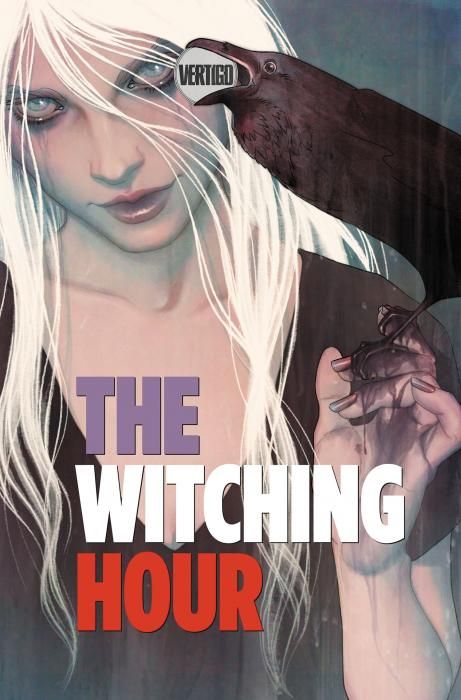"The Witching Hour" #1 continues Vertigo's themed one-shot anthology series with nine stories about witches and witchcraft, Anthologies are usually mediocre as a whole, but "The Witching Hour" has both strong talent and an unusually strong group of stories.
"Daniel" by Steve Beach, is a riff on the old link between witches, bigotry and persecution. Beach simple but potent plot twist confounds reader expectations. His fine linework and crosshatching shading makes the seance scene pleasantly creepy, but his approach is better represented by the realism of the emotional nuance in characters' faces. In "Daniel," witchcraft is real but it functions as insight, enabling the living to confront the complicity of silence and misplaced guilt.
"Birdie" by Lauren Beukes and Gerhard Human is supernatural crime vignette. The plot has no surprises, but Beukes has a fondness for dramatic bird imagery and a knack for developing the fantasy genre of magical realism within comics. The art is an excellent match, with Human's well-designed panels strengthened by Brusco's warm, joyous colors.
"Mars to Stay" by Brett Lewis and Cliff Chiang has a reality TV show setup, a common dystopian literary device these days from "Hunger Games" to "Punk Rock Jesus." The for-profit Martian expedition devolves rapidly into a "Lord of the Flies" crisis and the moral in the last panel is predictable. However, Lewis and Chiang's storytelling rhythm is solid, and the plot maintains the gripping suspense of its inherent elimination structure and whodunit mystery. Lewis creates a strong, believable voice for the main character, Tally. The quote from Pericles is both poetic and ironic, and the sideways inclusion of witchcraft is a pleasant, wordless surprise on the final page. Chiang's red and orange palette is heavy-handed but still works as a visual echo for Mars and a thematic echo of violence.
"This Witch's Work" by Annie Mok and Emily Carroll is a mood and memory piece with almost no plot. The witch in question is an abusive mother, and radio news works to unlock unpleasant associations and memories for the narrator, Reina, as she makes breakfast in her kitchen. Mok and Carroll's soft charcoal or crayon-like lines, vivid colors and an explosion of fractured panels build to a feverish climax, relaxed only by an ambiguous ending panel of cleansing waters mixed with possible tears.
"Legs" by Kelly Sue DeConnick and Ming Doyle is one of the weaker stories. While Doyle's art is great at creating a claustrophobic environment of secrets, the characters feel a little like paper dolls in the stiffness of their features and muscles. DeConnick simplistically reduces sympathy for Legs by making him a womanizer. The central revelation is out of left field, a pun about spiders recycled from old horror movies. The story's classic inversion of power has been done better elsewhere.
"Fellow Travelers" by Matthew Sturges and Shawn McManus has a clever premise. Arthur Miller, the American playwright, wrote "The Crucible," a dramatization of the Salem Witch Trials. Critics drew a connection between the play and Miller's own experiences with McCarthyism. In turn, Sturges writes a story about Miller in a fictional history and alternate reality, in which magic is real and witchhunts are still literal. Part parody, part fairy tale, "Fellow Travelers" is an original take on the McCarthy era and the romance between Miller and Marilyn Monroe.
In "Little Witch" by Ales Kot and Morgan Jeske, witches aren't a direct theme, but the bond between the titular narrator and the subject casts a dreamy spell-like atmosphere for this moody, sentimental story about memory and family. Jeske's panel composition and contrasting warm and cool colors builds emotional tension for the open ending.
"Run Ragged Part Three: "Gone to the Dogs" is another installment of the episodic Dead Boys Detectives story by Toby Litt, Mark Buckingham and Victor Santos. It's a fun, frivolous piece. The action and the characters are enjoyable, but the treatment of child abuse and the line between the living and the dead is handled with less subtlety than Neil Gaiman's original take on them in "Sandman."
"Rise" by Mariah Huehner and Tula Lotay is a straightforward tale of vengeance and possession. The story succeeds beautifully on the strength of the narrator's voice, and the Lotay's line is fluid and descriptive, with ethereal colors that lighten the melancholy and wry ending.
"The Witching Hour" is one of the strongest of Vertigo's themed anthologies so far, with fantastic art and admirable variety and daring in the interpretation of the theme.

